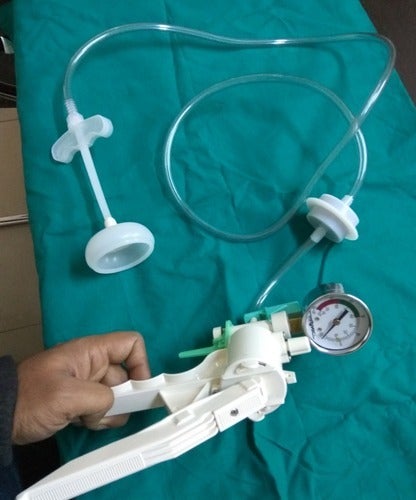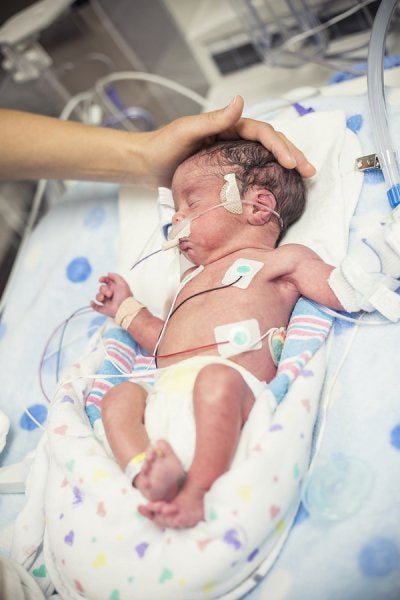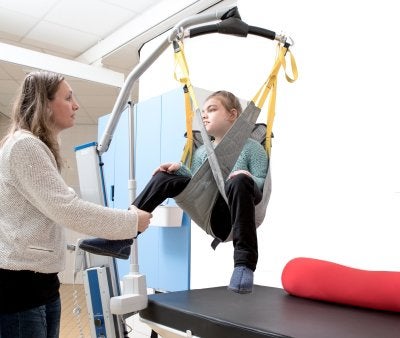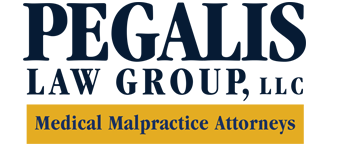-
What Are the Risks of Vacuum Assisted Deliveries?

For the most part, pregnancy and childbirth are natural processes. In some cases, however, mother and baby face risks, whether during the pregnancy or during labor. When there are complications, and the danger becomes too great, doctors often feel they must intervene to promote a positive outcome. When the intervention involves a vacuum assisted delivery however, there are significant risks involved.
* Why do doctors use vacuums? Sometimes at the end of a difficult labor, the doctor decides to help the process along using vacuum extraction if the mother or baby is in distress.
* How does the process work? Once the baby is low enough in the birth canal to be delivered, a vacuum cup is placed on the baby’s head, with suction applied so the cup doesn’t fall off. When the mother has another contraction, the mother pushes while the doctor pulls the baby using the vacuum cup.
* What risks does a patient face with a vacuum extraction? Vacuum extraction poses risks for the baby. Some of these are relatively minor complications like scalp lacerations or bleeding in the space under the fibrous portion of the skull bone. These typically clear up on their own, though the bleeding, called cephalohematoma, can sometimes require surgery. More serious complications include subgaleal hematoma, which is more serious bleeding below the scalp and can be life-threatening if a significant amount of blood is lost, or intracranial hemorrhage, which is bleeding under the skull that can lead to severe brain injury. There’s also a risk of skull fracture.
* What’s the responsibility of the doctor when choosing to use vacuum extraction? With all these risks, it’s clear that this intervention should only be used when absolutely necessary, and with informed consent from the mother. Often, there are signs and symptoms long before delivery, which should alert the medical care providers that it will be a difficult delivery. A discussion should be had with the mother about the option of a caesarian delivery, so as to avoid the potential risks associated with the use of a vacuum. Medical providers must inform patients of all the associated risks, and use this procedure only when it’s necessary and provided with the utmost competence.
If you or your baby suffered an injury during an assisted delivery, it may be time to contact a medical malpractice attorney. Pegalis & Erickson, LLC is here to help you, providing capable legal representation in the areas of New York. If you have questions about medical care or treatment, or a catastrophic injury, don’t delay in calling Pegalis & Erickson, LLC for a no-fee consultation! We obtain justice for our clients after hospitals, doctors, construction companies, and drivers commit preventable errors that cause harm. Reach us at (516) 684-2900.
Attorney Advertising
-
What Causes a Child’s Shoulder Dystocia?

When a baby’s head is delivered but the shoulders are stuck, it is known as shoulder dystocia. It is a rare but serious birth complication, and it can cause injury to the newborn. There are a number of factors that can make shoulder dystocia more likely to happen, including obesity, diabetes, and overdue pregnancy. Having a baby that is larger than usual, also known as large for gestational age, can also raise the risk of shoulder dystocia. Being alert to these risk factors can help your doctor take measures to help ensure that your delivery proceeds safely.
If you have any concerns about baby or mom after delivery such as a misdiagnosis or possible medical error, contact the law firm of Pegalis & Erickson, LLC in New York. For 46 years, we have advocated for people of all ages, in order to help our clients financially and make healthcare safer for everyone. You can reach us today by calling (516) 684-2900.
Attorney Advertising
-
Baby’s Injuries at Birth
The majority of births in the United States happen without notable complications. However, medical mistakes are too often made during labor and delivery and are not fully explained to parents, despite the resulting serious injuries that cause life-long harm. Here is a guide to some of the most serious types and causes of birth injuries:

Cerebral Palsy
Cerebral palsy is caused by permanent injury to a baby’s brain by trauma or a lack of oxygen. Cerebral palsy is a neurological condition with the common symptoms of seizures, speech delays, learning and other developmental delays and abnormal muscle tone. If complications during birth go unrecognized, they can cause lack of oxygen to the brain and permanent damage. Preventable birth injuries caused by misuse of vacuum extractors and other birth-assisting tools can increase the chances of traumatic injury to the brain.Erb’s Palsy
Erb’s palsy is the condition of nerve damage in the neck and arm with impaired motion in the arm and hand. The effects of the condition can run from severe to mild depending on how extensive the nerve damage is. The condition can be caused during birth if a doctor or midwife pulls on the baby’s head during delivery.Cortical Blindness
Cortical blindness also known as CVI is a type of birth injury that affects the ability to process visual information, such as depth perception and light perception. Cortical blindness frequently occurs along with cerebral palsy. CVI can be caused by decreased oxygen to the brain during the birth process. Other causes of CVI include hydrocephalus, developmental birth defects, head injury, and infections like meningitis. If healthcare providers discover, monitor, and remedy the conditions, irreversible damage may be avoided. The vision loss may be partial or total, but unfortunately is usually lifelong.If you are concerned about a misdiagnosis or possible medical error, contact the law firm of Pegalis & Erickson, LLC in New York. For 46 years, we have advocated for clients of all ages, to help their financial burden, and make future healthcare safer for others. You can speak directly to our attorneys by calling (516) 684-2900. There is no fee.
-
Do you know where your Brachial Plexus Is?
Every time you bend your wrist, raise your hand, or shrug your shoulders, you’re making use of your brachial plexus, a bundle of nerves centered in your spinal cord. The brachial plexus is responsible for controlling the movement of your entire arm! If a doctor or mid-wife uses force or twists a baby’s head during labor and delivery, it can result in injury to the baby’s nerves and chronic arm paralysis. This condition is known as Erb’s Palsy or Brachial Plexus palsy. While some children will make a full recovery as toddlers, other children move into their teens and adulthood not being able to enjoy full use of that arm. The condition will then continue through their lifetime. Treating Erb’s Palsy as soon as diagnosed can include a combination of physical therapy and nerve grafts. That oftent leads to a better lifetime outcome.
 If you wonder if your child’s disability could be the result of a medical error, it’s important that you talk with an experienced medical malpractice attorney. Pegalis & Erickson, LLC, can provide you with the professional legal guidance you require, at no charge. To reach our New York office, call us at (516) 684-2900.
If you wonder if your child’s disability could be the result of a medical error, it’s important that you talk with an experienced medical malpractice attorney. Pegalis & Erickson, LLC, can provide you with the professional legal guidance you require, at no charge. To reach our New York office, call us at (516) 684-2900. -
Is There a Cure for Erb’s Palsy?
 Erb’s palsy is a condition that affects approximately one in every 1,000 newborns. It involves nerve damage to the brachial plexus, the network of nerves in the upper arm. Infants who have Erb’s palsy may demonstrate a number of symptoms, including difficulty moving their hands, loss of feeling in their arms, or simply weakness throughout the arm. In some cases, the condition will resolve itself on its own, but it may take up to two years, and recovery may not be complete. Simple physical therapy exercises can be done to help the healing process along. In some cases, surgery may be recommended.
Erb’s palsy is a condition that affects approximately one in every 1,000 newborns. It involves nerve damage to the brachial plexus, the network of nerves in the upper arm. Infants who have Erb’s palsy may demonstrate a number of symptoms, including difficulty moving their hands, loss of feeling in their arms, or simply weakness throughout the arm. In some cases, the condition will resolve itself on its own, but it may take up to two years, and recovery may not be complete. Simple physical therapy exercises can be done to help the healing process along. In some cases, surgery may be recommended. At Pegalis & Erickson, LLC, we understand that medical malpractice is a difficult subject, especially when it affects an infant. If you are seeking legal guidance for a case of medical malpractice in Long Island, New York, call our legal team at (516) 684-2900 to schedule a consultation.
-
What Is the First Thing You Should Do if Your Child Is Injured During Childbirth?
Some birth injuries require immediate care, such as oxygen deprivation to the baby’s brain. After any sort of birth trauma is diagnosed, the first step to take is to ensure that your child gets the medical treatment he or she needs. Depending on your child’s specific condition, he or she may be admitted to the neonatal intensive care unit (NICU). Each hospital’s policies are a little different, but in general, parents can see their baby in the NICU as soon as the newborn has been stabilized and settled in. A nurse or patient navigator will explain what to expect from your child’s stay in the NICU.
 Once your baby is stabilized and the situation has calmed down, you should have a longer, in-depth conversation with the healthcare providers, which includes the neonatologist in charge of the NICU, who are treating your child. Take notes and ask plenty of questions. Ask whether your baby should have any additional medical tests or treatments, or should be seen by other specialists such as infectious diseases, pulmonology, cardiology, ophthalmology, and neurology, depending on the situation.
Once your baby is stabilized and the situation has calmed down, you should have a longer, in-depth conversation with the healthcare providers, which includes the neonatologist in charge of the NICU, who are treating your child. Take notes and ask plenty of questions. Ask whether your baby should have any additional medical tests or treatments, or should be seen by other specialists such as infectious diseases, pulmonology, cardiology, ophthalmology, and neurology, depending on the situation. Families affected by birth trauma near Long Island, New York can turn to the medical malpractice lawyers at Pegalis & Erickson, LLC. Call (516) 684-2900 for the answers to your legal questions.
-
How Birth Injuries Can Affect New Mothers
Birth injuries are a particularly tragic type of medical malpractice. It’s devastating to learn that a child will have a lifelong disability before he or she has a chance to enjoy childhood. Sometimes, new mothers are also affected by injuries during labor and delivery, and these can be fatal. After a wrongful death, families need answers and they deserve justice. A wrongful death lawsuit may be appropriate for some cases of maternal death.
Causes of Wrongful Death of the Mother

Despite the advanced healthcare system in the U.S., this country has the worst record for maternal deaths among developed nations, and more than half of those deaths are preventable. It’s possible for new mothers to suffer a fatal medical problem before going home from the hospital, but many of them die days or even weeks afterward. Some experts suspect that one reason for this is that the increased attention on the well-being of the newborn corresponds with a decrease in attentive care of the mother. As a result, hundreds of new mothers in the U.S. die from the following:
- Heart problems, including cardiomyopathy
- Massive postpartum hemorrhage
- Infections
- Preeclampsia (pregnancy-induced hypertension)
- Blood clots
Elements of a Maternal Death Case
Every civil lawsuit must have certain elements present to proceed. In maternal wrongful death cases, it must be proven that the mother’s death was the result of medical malpractice, and the surviving family has suffered losses as a result of the wrongful death, which can include loss of financial support, household services, love, and guidance. It’s possible for a lawyer to file the lawsuit against multiple parties, which may include the hospital, obstetrician, nurses, and other physicians who rendered negligent care and treatment.Consequences of Maternal Death
The death of a new mother is an unimaginable tragedy. The child will never have the opportunity to know his or her mother, and the other family members must cope with caring for a newborn in the midst of their grief, as well as their own individual loss. Nothing can make this situation better, but a lawsuit can give the family a sense of justice, as well as compensatory damages for medical expenses, funeral expenses, and loss of support and companionship.Pegalis & Erickson, LLC offers our sincere condolences to families affected by wrongful death. There is nothing that can bring your loved one back, but you may wish to pursue justice with a wrongful death lawsuit filed in New York. Call (516) 684-2900 and let us know how we can help your family.
-
Is Labor Induction Dangerous?
Labor induction is sometimes required if delaying birth could be dangerous to you or your child. In some pregnancies, a doctor may recommend labor induction for convenience, especially if you live far from the hospital. Although labor induction is a common procedure, it does carry risks. When medical mistakes are made before or during induction, those risks increase for both you and your child. Here are some risks of labor induction:
Increased Need for C-Section
After labor induction, the risk of needing a C-section increases. First-time mothers whose cervixes have not dilated appropriately may need a C-section after induction. Having a C-section introduces more risks into the delivery and recovery process, including an increased risk of infection for both you and your baby. It also extends the time it takes to recover from giving birth. Reduced Heart Rate
Reduced Heart Rate
When labor is induced, the medication used can cause many contractions. In addition to being painful, having too many contractions can lower your baby’s heart rate by reducing the supply of oxygen to the baby’s brain. Low heart rate and low oxygen levels can lead to birth injuries and other complications that can have lifelong effects for your child if there was a lack of proper medical monitoring and treatment.Increased Risk of Post-Delivery Bleeding
Inducing labor increases the risk of a serious condition called uterine atony, which causes dangerous hemorrhaging. Uterine atony occurs when the uterus doesn’t contract properly after giving birth. Labor induction increases the risk of uterine atony which happens more often after induction. Do you think you experienced an avoidable complication during labor induction? Do you believe your labor was unnecessarily induced, putting you at risk? Contact our experienced medical malpractice attorneys in New York at Pegalis & Erickson, LLC. If you have concerns please call us at (516) 684-2900. -
Reducing the Risk of Birth Injuries
Birth injuries can have lifelong consequences for parents and kids alike. Although some birth injuries are not preventable and some are caused by medical malpractice, it is possible to take steps to reduce your child’s risk of experiencing this kind of injury. If your child is injured during birth and you suspect that medical negligence played a role, contact a medical malpractice attorney to discuss your case. During your pregnancy, take these steps to reduce the chance of birth injuries.
Get Regular Prenatal Care
Prenatal care is essential for a healthy pregnancy, labor, and delivery. During your checkups, your doctor can ensure your pregnancy is proceeding as expected and identify any signs of complications that could interfere with a healthy delivery. For instance, if you are diagnosed with preeclampsia, then your doctor will provide treatment to protect you and your baby from the potential complications of that condition. If your doctor fails to identify a potential complication such as gestational diabetes or elevated blood pressure, and provide proper treatment to void a birth injury, contact a medical malpractice attorney to see if the mistake could be classified as medical malpractice. Have Screening Tests
Have Screening Tests
There is a range of screening tests that can be used during pregnancy to determine if you and your baby are progressing towards a healthy delivery. Attend all of your recommended ultrasound appointments and have any medical tests requested by your doctor. If your doctor diagnoses developmental problems with your baby during an ultrasound, determines that your baby is not in a safe position for birth, or diagnoses a medical problem through another kind of testing, he or she can take precautions during the delivery process. If you doctor doesn’t diagnose a problem that should have been clear from these diagnostic procedures and your child later experiences a birth injury, then medical negligence could be to blame.Maintain a Healthy Lifestyle
Some lifestyle choices you make during pregnancy, such as smoking or gaining more weight than is recommended, could increase your child’s chance of having a birth injury. Be sure to follow your doctor’s recommendations so you can have the best chance of a healthy delivery.At Pegalis & Erickson, LLC, we understand how confusing and stressful life can be in the aftermath of a birth injury. Our medical malpractice lawyers are here to help you decide what steps to take to protect your child’s future. To find out more, please call (516) 684-2900.
-
Common Questions About Cerebral Palsy
Cerebral palsy is a category of movement disorders. It is a non-progressive disorder, which means that it doesn’t grow worse over time. Unfortunately, it’s also currently incurable. Children with cerebral palsy have varying degrees and types of impairment, but parents can generally expect that they will require a lifetime of care. After the diagnosis, you may have lots of questions about what cerebral palsy means for your family. A cerebral palsy lawyer can guide you through this difficult transition.
What can cause cerebral palsy?
Cerebral palsy is the result of damage to the developing brain. This damage may be inflicted by injuries, diseases, or developmental disorders. It may occur during pregnancy or at or around the child’s birth. In some cases, cerebral palsy is the result of medical negligence. For instance, a healthcare provider may fail to detect and treat fetal distress during labor. Fetal distress may indicate a need for an emergency C-section to restore oxygen to the child’s brain and prevent brain damage. How will cerebral palsy affect my child?
How will cerebral palsy affect my child?
Cerebral palsy affects each child differently, although all forms of cerebral palsy affect a person’s movement, muscle tone, or posture. Some children have involuntary movements, rigidity, abnormal reflexes, problems swallowing, or eye muscle imbalance. A child with cerebral palsy may have any of the following problems:- Developmental delays
- Difficulty walking
- Speech delays
- Seizures
- Intellectual disabilities
- Psychiatric conditions
- Vision or hearing impairments
- Abnormal pain perceptions
- Swallowing issues
- Urinary incontinence
Are there any treatments available?
Although cerebral palsy is incurable, treatments are available to help children achieve greater functional abilities and better quality of life. A child’s treatment plan depends on his or her needs. Medications, physical therapy, and orthopedic surgery can improve problems associated with movement. Speech therapy can help children overcome communication barriers. Parents may be referred to a life care planner to get a good idea of the care their children will need for a lifetime.
The medical negligence law firm of Pegalis & Erickson, LLC puts its considerable resources to work on behalf of the families we represent. It’s our mission to help families affected by medical malpractice get the compensation they need to take care of their children. You can call (516) 684-2900 to request a confidential consultation with a cerebral palsy lawyer on Long Island, New York.
Recent Posts
Popular Posts
categories
- Uncategorized
- Infographic
- Patient Safety
- Patient Health
- Stillbirth
- Birth Injuries
- Medical Malpractice
- Medical Negligence
- Event
- Erb's Palsy
- Injury
- ER
- Video
- Cancer Misdiagnosis
- Medication Errors
- Cerebral Palsy
- Medical Negligence Lawyer
- Anesthesia Injuries
- Brachial Plexus
- Prostate Cancer
- About Us
- Men's Health
- Skin Cancer
- Breast Cancer
- Misdiagnosis
